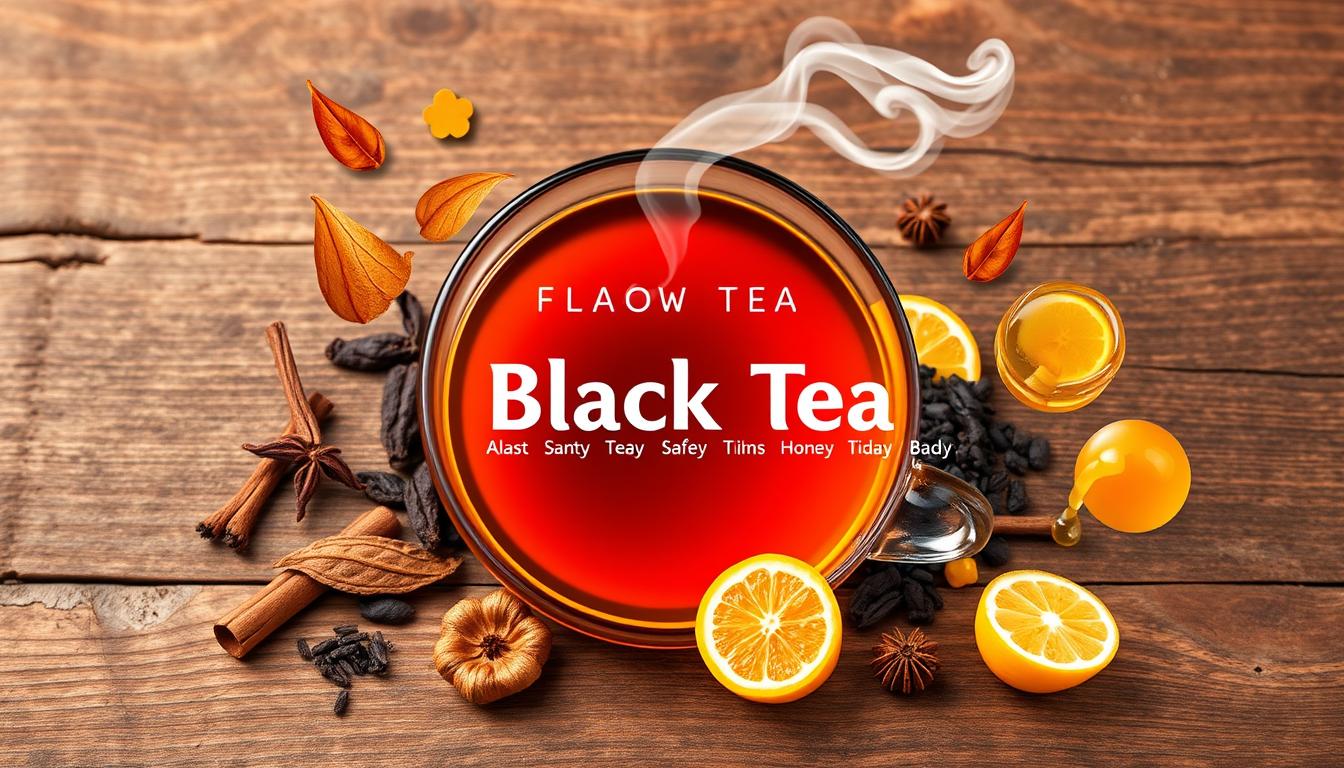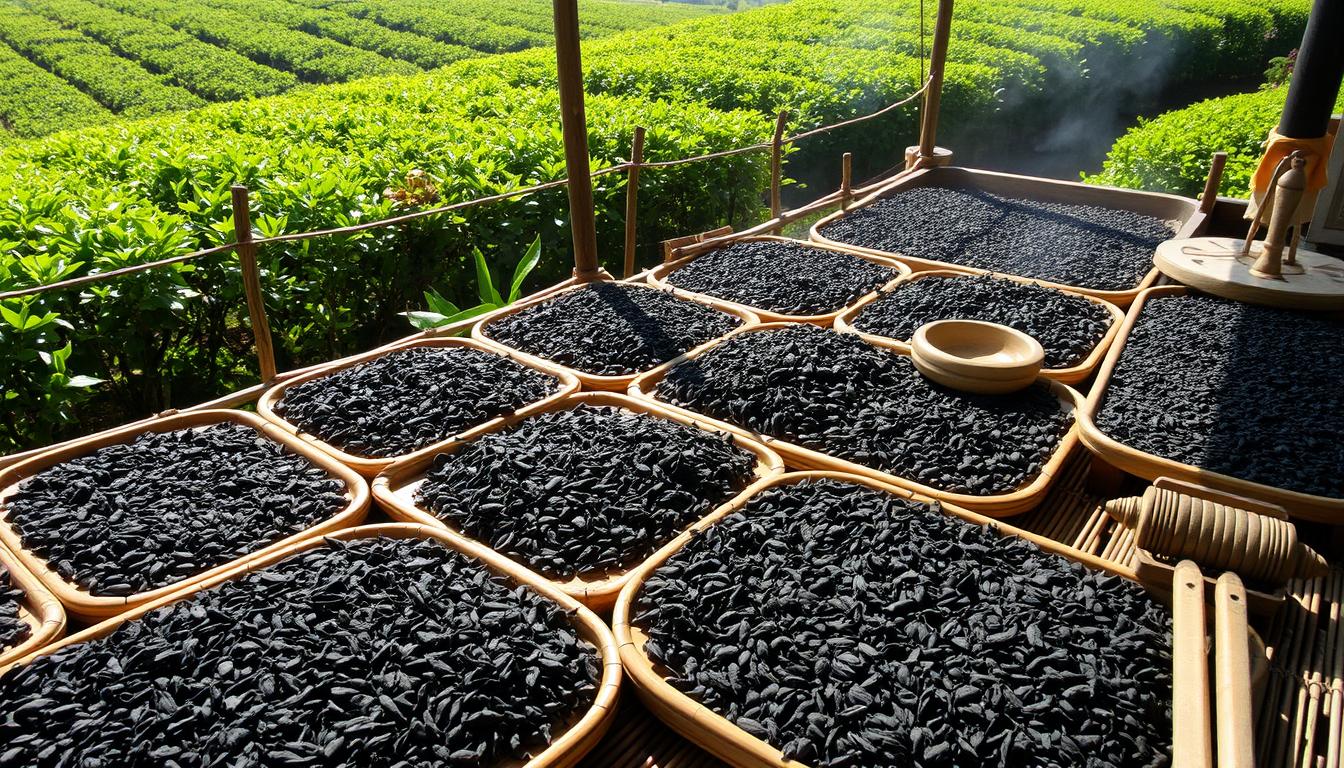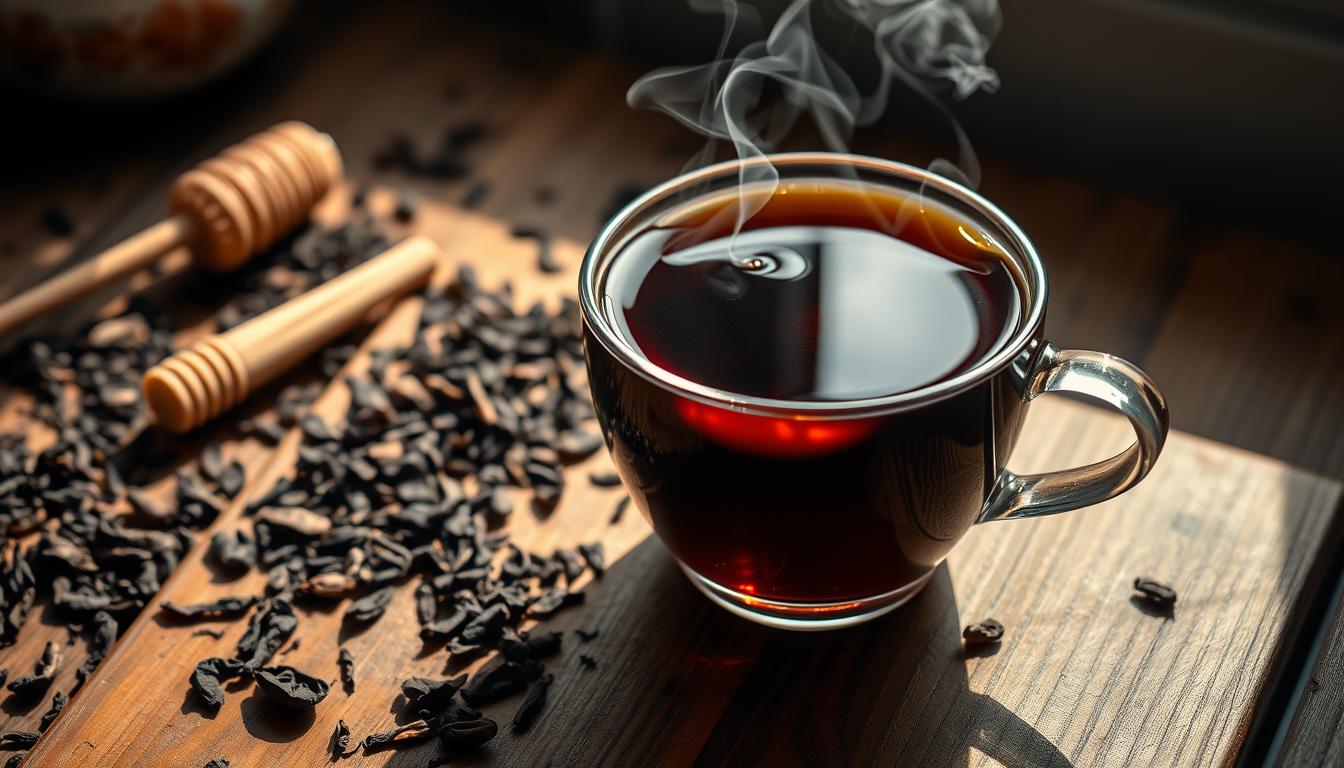Black tea is a favorite around the world for its bold flavor and health perks. Its taste can change based on the type and how it’s brewed. This article will take you into the world of black tea, exploring its rich flavors. It’s a guide to help you enjoy black tea’s unique taste.
The taste of black tea comes from how it’s made and brewed. We’ll cover the basics, types, and brewing methods. This will help you understand and enjoy black tea’s distinct flavor.
If you love tea or are new to it, this guide is for you. It’s all about black tea, from its taste to how to brew it. Our aim is to deepen your appreciation for black tea’s flavor and taste.
Key Takeaways
- Black tea is known for its rich, bold flavor and numerous health benefits.
- The black tea flavor is a complex blend of tastes that can vary depending on the type and brewing method.
- Understanding the basics of black tea is essential to appreciating its unique taste and flavor.
- The black tea taste is a result of the tea’s processing and brewing methods.
- Exploring different types and brewing methods can help you develop a deeper understanding and appreciation of the black tea flavor.
- The introduction to black tea provided in this article will help you get started on your tea journey.
Introduction: Understanding the Bold Flavor of Black Tea
Black tea is known for its unique black tea flavor profile. This flavor is due to the oxidation process. This process includes withering, rolling, and fermentation of tea leaves.
This process gives black tea its distinct taste and aroma. It’s why many tea lovers around the world enjoy it.
The black tea taste characteristics depend on several factors. These include the type of tea leaves, the climate, and how it’s made. There are many types of black tea, each with its own flavor.
For example, Assam tea has a strong, malty taste. Darjeeling tea, on the other hand, is delicate and floral. The variety of black tea flavors is vast and exciting.
The Allure of Black Tea Around the World
Black tea is loved all over the world. In the UK, it’s a key part of afternoon tea. In India, it’s a common drink, often enjoyed with spices and milk.
Its versatility has made black tea popular everywhere. It’s a favorite drink globally.
Why Black Tea Has a Stronger Flavor Than Other Teas
The oxidation process makes black tea stronger than other teas. This process takes longer, allowing for more complex flavors. As a result, black tea tastes richer and more full-bodied.
This process also makes black tea more caffeinated. It’s a popular choice for those looking for a energizing drink.

Whether you’re new to tea or a seasoned enthusiast, black tea has something for everyone. Its rich flavors and health benefits make it a great choice. It’s a delicious and satisfying drink.
The Basics of Black Tea: From Leaf to Cup
Black tea comes from the leaves of the Camellia sinensis plant. These leaves are withered, rolled, and fermented. This process gives black tea its unique flavor and aroma.
The black tea processing is key to its flavor. It’s what makes black tea different from other teas. Knowing how black tea production works helps us understand its complexity.
The tea oxidation step is vital in making black tea. It lets the tea leaves get their special flavor and color. This step can take hours or days, depending on the tea type.
The oxidation level changes the tea’s taste. More oxidized teas are often stronger and richer.

- Leaf quality: The quality of the tea leaves used in production can greatly impact the flavor of the final product.
- Oxidation level: The level of oxidation can affect the flavor of the tea, with more oxidized teas tend to be stronger and more full-bodied.
- Production methods: Different production methods, such as orthodox or CTC (cut, tear, curl), can also impact the flavor of the tea.
Understanding black tea production and tea oxidation helps tea lovers appreciate black tea’s complexity. Whether you’re new to tea or a seasoned drinker, knowing how black tea is made can make your enjoyment even better.
Primary Tasting Notes of Black Tea
Black tea is known for its rich and varied flavors. These come from the type of leaves, how it’s made, and how much it’s oxidized. Black tea flavor profiles often include malty, astringent, and sweet tastes. The tannins in black tea are key, adding astringency and balancing sweetness.
The black tea tasting notes change with each type. Some have fruity and floral hints, while others are robust and earthy. The oxidation level, a key step in making black tea, also shapes its flavor.
- Malty flavor notes, which are often associated with a rich, smooth taste
- Astringent taste, which can be attributed to the presence of tannins
- Sweet flavors, which can range from hints of honey to fruity notes
The mix of these flavors makes black tea special. It’s why many tea lovers enjoy it.
| Black Tea Type | Flavor Profile |
|---|---|
| Assam | Malty, strong, and full-bodied |
| Darjeeling | Light, floral, and slightly sweet |
| Earl Grey | Bergamot-infused, citrusy, and smooth |
Knowing about black tea’s primary tastes helps us enjoy its complexity and variety.
How Brewing Methods Influence Black Tea’s Taste
The method you use to brew black tea can change its taste a lot. Black tea brewing methods involve water temperature, steeping time, and how much tea you use. Knowing how these factors work together is key to getting the best flavor.
The water temperature for black tea is very important. It helps bring out the tea’s flavors and smells. Black tea usually needs water between 200°F and 212°F. The steeping time, which can be 3 to 5 minutes, also matters a lot. Tea brewing techniques can make the flavors stronger or softer, so it’s good to try different ways.
Here are some key things to think about when brewing black tea:
- Use fresh, high-quality tea leaves
- Adjust the tea-to-water ratio to suit your taste preferences
- Experiment with different steeping times and temperatures
By learning about black tea brewing methods and tea brewing techniques, you can get the most out of your black tea. Whether you like a strong or light flavor, the right way to brew can make a big difference. With some practice and patience, you can become great at brewing black tea and always have a perfect cup.
| Brewing Method | Water Temperature | Steeping Time |
|---|---|---|
| Hot Brew | 200°F – 212°F | 3 – 5 minutes |
| Cold Brew | Room temperature | 8 – 12 hours |
Exploring Popular Black Tea Varieties
There are many types of black tea, each with its own taste. Darjeeling tea is loved for its light and floral taste. Other favorites include Assam and Earl Grey, each with its own special flavor.
Darjeeling tea is known for being light and refreshing. Assam tea, on the other hand, has a strong and malty taste. Earl Grey tea has a citrus flavor from bergamot. Ceylon and Kenyan teas also have unique tastes, with Ceylon being light and Kenyan being full-bodied.
Some black teas are smoked or flavored, adding a twist to traditional teas. These teas can be a fun way to try something new. Whether you like Darjeeling’s light taste or Assam’s strong flavor, there’s a tea for you.
Exploring different black teas can help you find new favorites. With so many options, you’re bound to find the perfect tea for you.
Black Tea and Its Complex Tastes: Sweetness, Bitterness, and Astringency
Black tea’s flavor balance is key to a great taste. The right mix of sweetness and bitterness makes it refreshing and satisfying. Astringency adds a drying feel, balancing the sweetness.
Sweetness in black tea comes from natural sugars in the leaves. Bitterness is from tannins. Astringency comes from polyphenols, which dry the mouth and throat.
Understanding the Balance of Sweetness and Bitterness
To enjoy black tea, knowing how sweetness and bitterness work together is important. A good black tea balances these flavors well. Sweetness enhances the taste, while bitterness adds depth.
Reducing Bitterness and Astringency in Black Tea
If black tea is too bitter or astringent, there are ways to fix it. Using cooler water and shorter steeping times can make it smoother. A bit of milk or honey can also balance out the flavors.
Tea lovers can appreciate black tea’s complex flavors. Whether you like strong or smooth black tea, finding the right flavor balance is key. This way, you can enjoy black tea to its fullest.
| Black Tea Variety | Sweetness Level | Bitterness Level | Astringency Level |
|---|---|---|---|
| Assam | Medium | High | Medium |
| Darjeeling | High | Low | Low |
| Earl Grey | Medium | Medium | Low |
The Impact of Growing Region on Black Tea Flavor
Black tea’s taste is greatly influenced by where it grows. The climate, soil, and height of each area make black tea unique. For example, Darjeeling’s high altitude and cool weather make its black tea light and floral.
India, Sri Lanka, and China have black tea with different tastes. These differences come from the soil, weather, and rain. The place where tea grows greatly affects its flavor.
Several things shape black tea’s taste:
- Climate: Weather and rain affect the tea’s flavor
- Soil: The type and quality of soil change the taste and smell of tea
- Altitude: Higher places make teas lighter and more floral
Darjeeling is famous for its high-quality black teas. Its unique mix of high altitude, cool weather, and clear seasons gives its teas a special taste.
In summary, where black tea grows is very important for its taste. Knowing about the terroir and flavor of different places helps tea lovers enjoy each tea’s unique qualities. This knowledge helps them choose the right black tea for their taste.
| Region | Climate | Soil | Altitude | Flavor Profile |
|---|---|---|---|---|
| Darjeeling | Cool and wet | Acidic soil | High | Light and floral |
| Assam | Hot and humid | Rich soil | Low | Strong and malty |
| Ceylon | Warm and sunny | Well-drained soil | Medium | Balanced and nuanced |
How Freshness and Storage Affect Black Tea Flavor
Keeping black tea fresh is key to its great taste. Fresh black tea offers complex flavors like malt, honey, and fruit. But, bad storage can make it taste stale and bitter.
To keep black tea’s flavor, store it right. Keep it away from light, heat, and moisture. Storing it in a cool, dry spot helps keep its taste and smell.
Why Fresh Black Tea Tastes Better
Fresh black tea is better because it’s full of antioxidants and flavor. As it ages, these things break down. This makes the tea less tasty.
How Improper Storage Can Alter the Taste of Black Tea
Bad storage can make black tea taste stale and bitter. Light, heat, and moisture cause it to oxidize. This makes the tea less flavorful.
Tips for Preserving Black Tea’s Flavor
- Store black tea in a cool, dry place
- Keep black tea away from light and heat
- Use airtight containers to store black tea
Follow these tips to keep your black tea fresh. This way, every cup will be as tasty as the first.
Pairing Black Tea with Food: Enhancing the Flavor Experience
Exploring black tea food pairing opens up a world of flavors. Whether it’s sweet treats or savory meals, black tea can enhance many tastes. The key is to match the black tea type with the dish’s flavors. For instance, a robust Assam black tea goes well with spicy foods. Meanwhile, a light Darjeeling black tea suits lighter dishes better.
Here are some tea pairing tips to keep in mind:
- Pair black tea with foods that have similar flavor profiles, such as pairing a smoky black tea with grilled meats.
- Consider the level of bitterness and astringency in the black tea and balance it with sweet or creamy flavors.
- Don’t be afraid to experiment and try new pairing black tea with meals combinations to find your favorite.
Some popular black tea food pairing options include:
| Black Tea | Food Pairing |
|---|---|
| Earl Grey | Lemon bars or citrus-based desserts |
| English Breakfast | Hearty breakfast dishes, such as eggs and bacon |
| Darjeeling | Delicate finger sandwiches or scones with jam and cream |
By following these tea pairing tips and trying different black tea food pairing options, you can make your meals more enjoyable. Enjoy the perfect cup of black tea with your favorite dishes.
Conclusion
Black tea is a drink with a rich and complex taste. It ranges from malty and astringent to sweet and floral. Understanding how it’s made and brewed helps you find your favorite.
If you love black tea or are just starting, try new ones. Discover the unique tastes of Darjeeling, Assam, and Earl Grey. Don’t forget to explore smoked and flavored teas too. This will open up a world of flavors that will make you want more.

